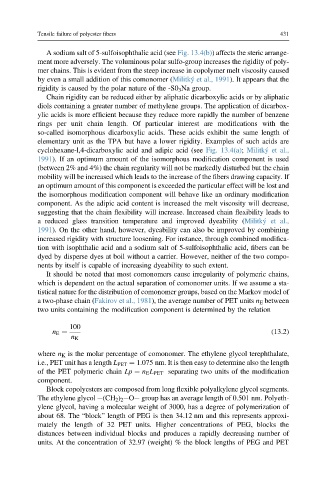Page 458 - Handbook of Properties of Textile and Technical Fibres
P. 458
Tensile failure of polyester fibers 431
A sodium salt of 5-sulfoisophthalic acid (see Fig. 13.4(b)) affects the steric arrange-
ment more adversely. The voluminous polar sulfo-group increases the rigidity of poly-
mer chains. This is evident from the steep increase in copolymer melt viscosity caused
by even a small addition of this comonomer (Militký et al., 1991). It appears that the
rigidity is caused by the polar nature of the -S0 3 Na group.
Chain rigidity can be reduced either by aliphatic dicarboxylic acids or by aliphatic
diols containing a greater number of methylene groups. The application of dicarbox-
ylic acids is more efficient because they reduce more rapidly the number of benzene
rings per unit chain length. Of particular interest are modifications with the
so-called isomorphous dicarboxylic acids. These acids exhibit the same length of
elementary unit as the TPA but have a lower rigidity. Examples of such acids are
cyclohexane-l,4-dicarboxylic acid and adipic acid (see Fig. 13.4(a); Militký et al.,
1991). If an optimum amount of the isomorphous modification component is used
(between 2% and 4%) the chain regularity will not be markedly disturbed but the chain
mobility will be increased which leads to the increase of the fibers drawing capacity. If
an optimum amount of this component is exceeded the particular effect will be lost and
the isomorphous modification component will behave like an ordinary modification
component. As the adipic acid content is increased the melt viscosity will decrease,
suggesting that the chain flexibility will increase. Increased chain flexibility leads to
a reduced glass transition temperature and improved dyeability (Militký et al.,
1991). On the other hand, however, dyeability can also be improved by combining
increased rigidity with structure loosening. For instance, through combined modifica-
tion with isophthalic acid and a sodium salt of 5-sulfoisophthalic acid, fibers can be
dyed by disperse dyes at boil without a carrier. However, neither of the two compo-
nents by itself is capable of increasing dyeability to such extent.
It should be noted that most comonomers cause irregularity of polymeric chains,
which is dependent on the actual separation of comonomer units. If we assume a sta-
tistical nature for the distribution of comonomer groups, based on the Markov model of
a two-phase chain (Fakirov et al., 1981), the average number of PET units n E between
two units containing the modification component is determined by the relation
100
n E ¼ (13.2)
n K
where n K is the molar percentage of comonomer. The ethylene glycol terephthalate,
i.e., PET unit has a length L PET ¼ 1.075 nm. It is then easy to determine also the length
of the PET polymeric chain Lp ¼ n E L PET separating two units of the modification
component.
Block copolyesters are composed from long flexible polyalkylene glycol segments.
The ethylene glycol e(CH 2 ) 2 eOe group has an average length of 0.501 nm. Polyeth-
ylene glycol, having a molecular weight of 3000, has a degree of polymerization of
about 68. The “block” length of PEG is then 34.12 nm and this represents approxi-
mately the length of 32 PET units. Higher concentrations of PEG, blocks the
distances between individual blocks and produces a rapidly decreasing number of
units. At the concentration of 32.97 (weight) % the block lengths of PEG and PET

